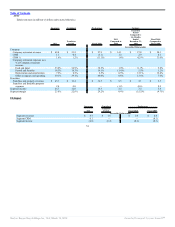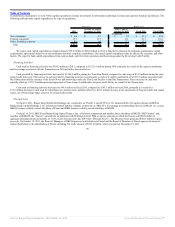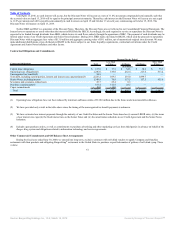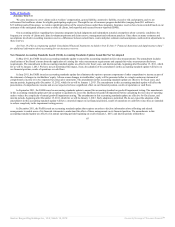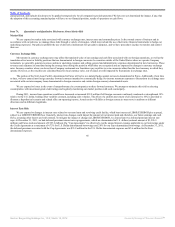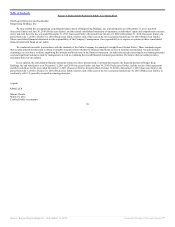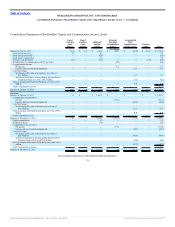Burger King 2011 Annual Report Download - page 65
Download and view the complete annual report
Please find page 65 of the 2011 Burger King annual report below. You can navigate through the pages in the report by either clicking on the pages listed below, or by using the keyword search tool below to find specific information within the annual report.
Table of Contents
with and arising from our use and eventual disposition of the assets. If the net carrying value of a group of long-lived assets exceeds the sum of related
undiscounted estimated future cash flows, we would be required to record an impairment charge equal to the excess, if any, of net carrying value over fair value.
When assessing the recoverability of our long-lived assets, we make assumptions regarding estimated future cash flows and other factors. Some of these
assumptions involve a high degree of judgment and also bear a significant impact on the assessment conclusions. Included among these assumptions are
estimating undiscounted future cash flows, including the projection of comparable sales, restaurant operating expenses, capital requirements for maintaining
property and equipment and residual value of asset groups. We formulate estimates from historical experience and assumptions of future performance, based on
business plans and forecasts, recent economic and business trends, and competitive conditions. In the event that our estimates or related assumptions change in
the future, we may be required to record an impairment charge.
See Note 2 to our audited Consolidated Financial Statements included in Part II, Item 8 “Financial Statements and Supplementary Data” for additional
information about accounting for long-lived assets.
Accounting for Income Taxes
We record income tax liabilities utilizing known obligations and estimates of potential obligations. A deferred tax asset or liability is recognized whenever
there are future tax effects from existing temporary differences and operating loss and tax credit carry-forwards. When considered necessary, we record a
valuation allowance to reduce deferred tax assets to the balance that is more likely than not to be realized. We must make estimates and judgments on future
taxable income, considering feasible tax planning strategies and taking into account existing facts and circumstances, to determine the proper valuation
allowance. When we determine that deferred tax assets could be realized in greater or lesser amounts than recorded, the asset balance and income statement
reflect the change in the period such determination is made. Due to changes in facts and circumstances and the estimates and judgments that are involved in
determining the proper valuation allowance, differences between actual future events and prior estimates and judgments could result in adjustments to this
valuation allowance.
We file income tax returns, including returns for our subsidiaries, with federal, state, local and foreign jurisdictions. We are subject to routine examination
by taxing authorities in these jurisdictions. We apply a two-step approach to recognizing and measuring uncertain tax positions. The first step is to evaluate
available evidence to determine if it appears more likely than not that an uncertain tax position will be sustained on an audit by a taxing authority, based solely on
the technical merits of the tax position. The second step is to measure the tax benefit as the largest amount that is more than 50% likely of being realized upon
settling the uncertain tax position.
Although we believe we have adequately accounted for our uncertain tax positions, from time to time, audits result in proposed assessments where the
ultimate resolution may result in us owing additional taxes. We adjust our uncertain tax positions in light of changing facts and circumstances, such as the
completion of a tax audit, expiration of a statute of limitations, the refinement of an estimate, and interest accruals associated with uncertain tax positions until
they are resolved. We believe that our tax positions comply with applicable tax law and that we have adequately provided for these matters. However, to the
extent that the final tax outcome of these matters is different than the amounts recorded, such differences will impact the provision for income taxes in the period
in which such determination is made.
We use an estimate of the annual effective tax rate at each interim period based on the facts and circumstances available at that time, while the actual
effective tax rate is calculated at fiscal year-end.
See Note 10 of the accompanying audited Consolidated Financial Statements included in Part II, Item 8 “Financial Statements and Supplementary Data”
for additional information about accounting for income taxes.
64
Source: Burger King Holdings Inc, 10-K, March 14, 2012 Powered by Morningstar® Document Research℠


